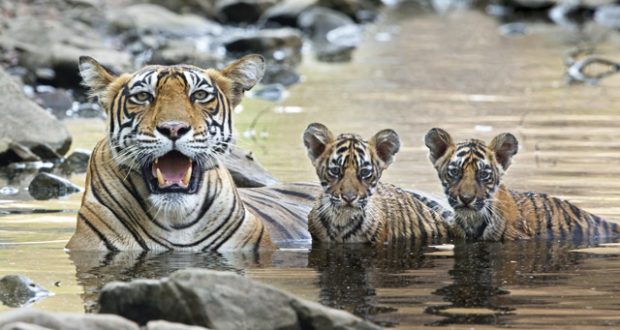
In a landscape that makes for thrilling vistas, the Queen of the Ranthambore wilderness proves hard to seek
View online at natgeotraveller.co.uk
The rocky ravines and plateaus of the Aravalli Hills ripple across the skyline like the folds of a saree. This landscape makes for thrilling vistas — and a bone-rattling safari drive — but can be infuriating.
“That’s it. We can’t follow them any further,” Farooq curses from the front passenger seat, peering into the valley below us. Our driver revs the engine and edges the vehicle nearer to the ridge of the basin. All morning we’ve tracked the paw marks of a mother and two cubs like clues in a treasure hunt, then followed a cacophony of warning cries. The barks of sambar deer and calls of langur monkeys echo in the impassable valley. The tigers are on the move.
“We’ll have to give up and try a different territory,” Farooq demurs. My frustration quickly dissipates as we roll onwards through Ranthambore and emerge at a lake where scores of snub-nosed marsh crocs bask statue-still on the shore. An iridescent kingfisher dips its wings into the mirrored surface before vanishing into the dazzling sky. It’s a fantastic scene.
Scattered around the lake territory are crumbling, domed chhatris built by the old maharajas of Jaipur to facilitate their hunting parties. When the British introduced guns to the sport, a massacre ensued: an estimated 80,000 tigers were killed across India between 1875 and 1925. Even the Queen and Prince Philip came to shoot tigers in Ranthambore in the 1960s, before conservationists, like Fateh Singh Rathore, successfully campaigned to stop the bloodshed in 1973. Today just 2,200 tigers remain in India — 62 in Ranthambore.
As we pull up to a ruin, slithering with thick vines and shaded by palms trees, I feel like I’ve stepped into The Jungle Book. Nature has enveloped these remnants of history and I half expect Shere Khan to leap like liquid fire from the undergrowth and chase us away.
Farooq tells me that this lake territory used to belong to a fearsome tigress named Machali. She would stalk the wetlands’ spotted deer, wrestle its giant crocs and wallow in its shallows, completely uninhibited by human onlookers. Until her death in 2016, she was the most photographed tiger in the world. “Photographs are so important in raising global awareness,” Farooq tells me. “Who could not come to the aid of the tiger when they know its beauty and the danger it’s in?” I’d be more than happy to take some snaps but the new queen of the lakes, Arrowhead, is nowhere to be seen. In fact, all the tigers seem to be having a morning off.
A safari drive in Ranthambore isn’t luxurious — its riches lie in its wildlife. Living under the tigers’ dominion in the national park are mammals including leopards, striped hyenas, blue bulls, jungle cats, wild cats, caracals, porcupines and mongooses, as well as dozens of reptiles and some 270 bird species. And these animals don’t respect the sanctity of park boundaries: big cats have been known to slink into the campstead of Khem Villas where I’m staying. The resident naturalist shows me camera trap footage of a tigress named Lightning prowling through the grounds at night.
On my last safari drive, Farooq and I surprise a sloth bear in a banyan grove. It’s a rare sighting. “What luck!” Farooq exclaims. The driver switches off the engine, and as the shaggy black bear slopes away, I subject the party to the chorus of Bare Necessities. I don’t see a tiger in Ranthambore — but as The Jungle Book moments go, I’m still thrilled to have seen Baloo.
Top 4 tiger spots:
Bandhavgarh National Park, Madhya Pradesh
Some 50 tigers live here, making sightings relatively frequent. The scenery is magical, too: the area has been the seat of numerous dynasties dating back to 800BC and is peppered with romantic ruins.
Tadoba-Andhari Tiger Reserve, Maharashtra
The secret’s out: Tadoba is currently the best place to spot a big cat. Over 60 tigers live among its teak forests and lakes at the last count, and the density of this population means most tiger enthusiasts leave happy.
Kanha National Park, Madhya Pradesh
Kanha is considered one of India’s most beautiful parks. It’s home to 40-45 tigers but sightings have decreased over recent years, and so it’s worth spending upwards of three days on safari to increase the odds.
Corbett Tiger Reserve, Uttarakhand
This vast wilderness in the foothills of the Kumaon region is partly out of bounds to visitors, dedicating its heartlands purely to conservation. It’s still a stunning place to look for big cats, although its 215 tigers are known to be elusive.
ESSENTIALS
Inspiring Travel Company has a seven-night trip from £2,975 per person, including three nights at Khem Villas, Ranthambore, in a cottage; five private game drives in Ranthambore; three nights at Samode Haveli, Jaipur in a deluxe suite; and one night in Delhi at the Holiday Inn. This price also includes international flights, car transfers, and train travel from Delhi to Ranthambore.
Published in the October 2018 cover story of National Geographic Traveller (UK)











